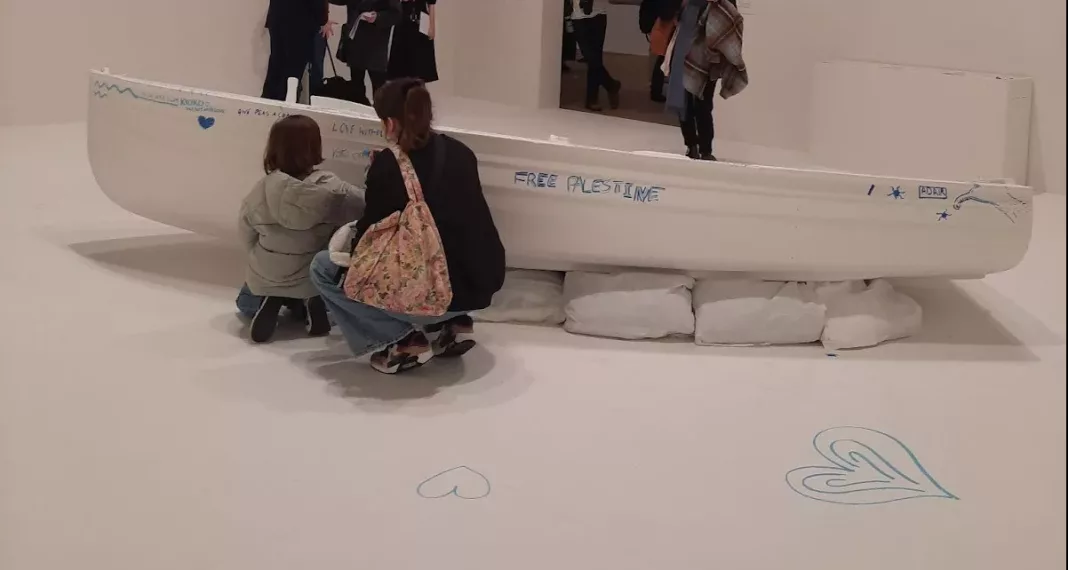(Image credit: Taya Neilson)
‘Soon there will be no need for artists, since people will start to write their own instructions or exchange them and paint’ (Letter to Ivan Karp from Yoko Ono, 1965)
Tracing seven decades of Yoko Ono’s multidisciplinary approach to art, the exhibition YOKO ONO: MUSIC OF THE MIND is a celebration of her interactive and often radical work. As such, a symphony of sounds struck me upon first entering the main gallery room of the exhibition at the Tate Modern. Her ‘Music of the Mind’ was very much present and alive. The general buzz amongst visitors, the projection of Ono’s films onto the gallery walls and her voice added a dimension of musical performance to the exhibition, contrasting the traditional silence expected in art galleries.
The usual compelling force to remain quiet within the art gallery was thus removed; visitors did not stare at the work created by Ono in silence for a prolonged period of time or awkwardly shuffle to the side to make room for the next observer, their brows stern as they inspected the pieces on display. Instead, visitors were constantly mobile and vocal as they moved from one interactive piece to the next. The gallery space itself did not provide an atmosphere of silence, but rather upon observation, isolated moments of contemplation and quietness were evident amongst the bustling scene in the room.
Ono’s installation Add Colour (Refugee Boat) is an example of how viewers interacted with her work to create their own collaborative art. It started as an all-white boat in an all-white room and, as the day progressed, it became a mural adorned with blue messages. Visitors expressed their own thoughts regarding the ongoing refugee crisis present today in contemporary society through the medium of art as they responded to Ono’s instructions that ‘Just blue like the ocean’ they should contribute their own hopes and beliefs in blue and white. The collaborative creation of this piece, therefore, reflects on the ability to make a significant impact through collective action. Yet, alone in that very room was a little girl, clasping a pen marker bigger than her hand. The girl was not aware of the messages written across the walls or the press that stood to the side of the room, but rather she was circling the white boat, deciding where to make her mark. It soon became apparent that she was finding the perfect place to write Ono’s name. An act of commemoration occurred at that very moment and the artist herself became part of the collective wall of messages encapsulating human agency and joint-responsibility.
Another two men participated in the White Chess Set—a game consisting of white chess pieces and the instruction ‘play as long as you can remember where all your pieces are’. They avidly leant forward to observe the game unfolding, so focused and unfettered by their fellow visitors walking past. First released in 1966, White Chess Set demonstrates Ono’s anti-war stance, making the interactive element of her piece extremely significant. As the chess pieces are indistinguishable, Ono’s modifications encourage the players to collaborate in order to establish a truce between them. She wanted her art to engage its viewers, feeling it necessary to directly communicate the importance of world peace to her fellow activists and neighbours.
In May 1971, Ono revealed how she believed anyone could be an artist and that, in her view, paintings went through a life transformation when people engaged directly with them.1 This explains the presence of Ono’s ‘instruction pieces’ throughout the exhibition. A particular moment caught the attention of the room during the press morning: a sudden banging as a girl engaged with Ono’s piece Painting to Hammer a Nail. As soon as the loud clamour was heard, photographers clustered around this spontaneous performance. The girl not only became an artist in her own right, hammering a nail into the blank canvas as instructed by Ono, but she also simultaneously became part of the art, as photographs were taken capturing this event.
(Image credit: Taya Neilson)
By instructing others to add to her work, rather than merely repeating it, Ono noted in 2001 that she felt like she was representing the whole artistic community and releasing herself from her position amongst an elite group of artists. The exhibition YOKO ONO: MUSIC OF THE MIND, therefore, cleverly relates Ono’s artwork to her world views. Rather than taking the position of the ‘elite’ artist, Ono removes the hierarchy established between the artist and viewer through her instructions. Her collaborative artwork and performances were thus created to reflect on the importance of collective activism and agency in order to campaign for world peace and social justice.
- Yoko Ono, What is the relationship between The World and The Artist? (May 1971). Available at: https://www.imaginepeace.com/archives/2622. ↩︎


